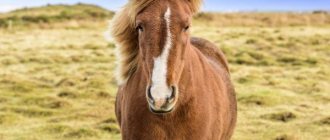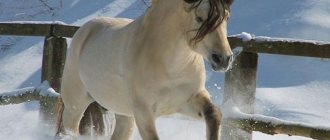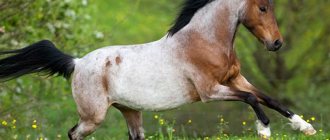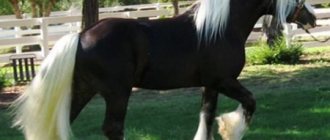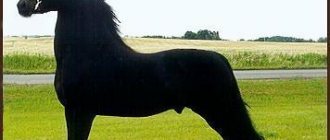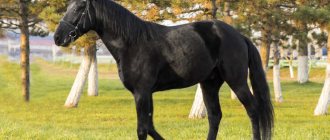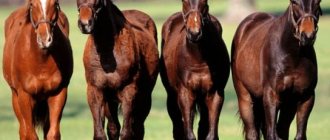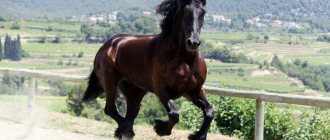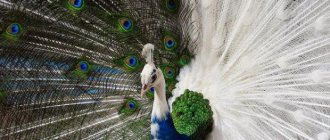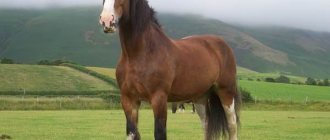ExpertBusiness
The popularization of equestrian sports in the country will be able to give impetus to the revival of Russian horse breeding and the return of the position of domestic horses in the world market
Liliya Boyko
Few of us realize how huge this industry is - horse breeding. According to the roughest estimates, approximately $300 billion is circulating in the world. Our country’s place in the global horse breeding industry is still very modest.
In February, representatives of the horse breeding industry met at the forum “Russian Horse Breeding and Export: Myth or Reality,” which was jointly organized by the Rosplemkonzavod Association, the All-Russian Research Institute of Horse Breeding and the Timiryazev Academy. One of the prerequisites for the meeting was the decision of the Russian government to increase the volume of exports of agricultural products to $45 billion per year in 2024. And horse breeders decided not to stand aside. Forum participants discussed the state of the industry, many important details related to the transportation and registration of animals, and other relevant topics. However, among the speakers there was not a single horse breeder who had experience in exporting horses; there was not a single shining success story; markets and consumer profiles, specific numbers were not discussed.
The industry, as many participants put it, is “lying” or on the verge of survival.
Nevertheless, the export of horses from Russia is not at all a myth: in 2017, according to the UN Statistics Office, our country exported 140 thoroughbred horses and 552 non-pedigree horses. The annual income from the export of thoroughbred horses, according to the same source, amounted to 295 thousand dollars. This is roughly comparable to the cost of one purebred foal with a stellar pedigree from Great Britain, which, by the way, is among the top leading exporters year after year. In the same year, the UK earned $406.5 million from the export of thoroughbred horses.
Historically, Russia is an equestrian power, and horses are an integral part of cultural tradition. At the beginning of the twentieth century, our country had the largest population of these animals, so the current meager numbers are especially offensive. Before perestroika, the USSR was a significant player at the international level. The auctions, which were held at many stud farms, attracted buyers from all over the world. Alas, those auctions are no longer there, many positions have been lost, traditional buyers and markets have been lost, and it will be very difficult to restore them. The list of problems includes the quality of horses, the level of their training, and the ability to sell - modern marketing, integration into the world system, reputation. The losses of the nineties include the broken ties between athletes, a wide layer of the physically active population and horse breeders, and the fact that the development of horse breeding in Russia took on a spontaneous character.
Tarpan
The wild ancestor of the European domestic horse was the tarpan, which lived in the steppe and forest-steppe zones of Eurasia. It is believed that the tarpans became extinct due to the plowing of the steppes, displacement by herds of domestic animals, and were to a small extent exterminated by humans. During the winter starvation, tarpans often ate the hay reserves left in the fields and meadows. It happened that during the rut the tarpans captured and stole domestic mares, for which the man persecuted them. A herd of domestic horses, once free, quickly runs wild and begins to lead a lifestyle characteristic of its wild ancestors. Tarpan meat was considered a rare and delicious food. Tarpans lived for the longest time in the Black Sea steppes. There they disappeared only in the second half of the 19th century.
Mustangs
Mustangs are the name given to the feral horses of America that were brought to the New World by European colonialists. Mustangs appeared on the American prairies and savannas as early as the 16th century. By the beginning of the 20th century, there were about 2 million mustangs in America. They were popular hunting objects at that time. Mustang hunting and grazing reduction have significantly reduced the feral horse population. To date, about 10-20 thousand mustangs have survived.
Camargue horses of France
In France, in the Rhone delta, the Camargue population of semi-wild white, that is, light gray, horses has been preserved.
The wild horse was an inhabitant of open spaces. She could flee in case of danger.
Geography of horse breeding by continent
Before the arrival of Europeans, there were no horses in America and Australia. However, now more than half of the world's horse population is concentrated in America and accounts for 53%. In Asia 27% of horses, in Europe 12%, in Africa 8%. Australia and Oceania account for less than 1% of the horse population. There are 430 horse breeds known in the world. Horse breeding is concentrated mainly in treeless and sparsely forested areas: steppes and forest-steppes, savannas and prairies, and rarely in semi-deserts. In the past, the wild horse lived in open spaces, so it managed to escape from danger with the help of its fast legs. Currently, people use open spaces for breeding. One area for the development of horse breeding begins in the forest-steppes and steppes of the Old World, that is, in Western Europe, passes through Middle and Central to the Pacific coast. The second range borders the Sahara from the south. This range includes the Sahel countries from Senegal to Ethiopia.
Horse management
Owning horses requires significant expenses. Horses are demanding when it comes to feed. On pasture they eat from 25 to 100 kg of grass per day. To feed one horse you need about 2 hectares of land. Depending on age and live weight, a horse drinks an average of 30-60 liters of water per day in summer and 20-25 liters in winter. Horse breeding is an extensive branch of livestock farming.
Herd method
Horses can be kept in herds or stables. When keeping herds, animals are kept on pastures around the clock. On pastures, herds of horses feed on succulent grasses.
Stable method
In the stable method, horses are kept in stables sheltered from the weather. When keeping horses in stables, special paddocks are required for walking animals. The feed for horses kept in stables consists mainly of oats and hay or straw. The horses are also given root vegetables, potatoes and other food.
The method of keeping horses varies depending on the season of the year and climatic conditions. In summer, horses are grazed in herds on pastures, and in winter they are kept under a roof in stables.
Number of horses in the world
In recent decades, the number of horses in the world has been declining. It was greatest in the 30s of the twentieth century, and amounted to about 120 million heads. This is due to the growth of mechanization of agriculture and transport, the decline in the importance of cavalry as a branch of the military. In 1985, there were 64 million horses in the world, and in 2011 - 58 million. In the last decade, the United States became the first country in the number of domestic horses, although in the 1990s this country ranked 4th in the world after China and Brazil. Unlike other countries, the number of horses in the United States is constantly growing (5 million in 1992, 8 million in 2004,
Horse plus man
The specificity of the industry is that its development is based on a tandem: a horse plus a rider or equestrian (equestrian sport is the only Olympic sport in which an animal and a person participate; according to the regulations, they enter the awards together). This is what makes the industry unique, taking it beyond simple agricultural production. The most prominent developments in the industry are horse racing, sports and riding as part of a lifestyle, sometimes referred to as "leisure" for short.
The uniqueness of equestrian sport is that there are no restrictions on gender or age - women and men compete on equal terms even in Olympic disciplines. Compared to other sports, the age group “over 45” is more widely represented here, as well as people with disabilities. This is a virtually unlimited market.
Europe and America managed to maintain the industry even after the need for horses in military affairs, agriculture and as the main means of transport was no longer necessary. Traditions have changed, but continue to live. Foreign experience shows that neither scientific and technological progress nor changes in living conditions of the population are critical factors for the destruction of the horse industry. And this is exactly what happened in our country. Among the reasons are the underdeveloped domestic market, weak infrastructure, high cost of keeping horses, low level of trust, shortage or insufficient qualifications of personnel, mass import of foreign horses of average and “below average” quality.
The Oryol trotting horse breed has been preserved thanks to the efforts of Russian horse breeders
Current use of horses
Currently, horses are bred for various purposes: as draft power, for meat, for milk, for participation in sports competitions, for tourism and recreation.
For a long time, horses were the main means of land transport; they were ridden on horseback and harnessed to various carts and sleighs. It was horse traction that was used in stagecoaches and horse-drawn horses that were used as the first types of intercity and urban public transport. The era of horses as the main means of transport over short distances ended in the first half of the twentieth century.
However, in some remote and inaccessible areas, for example, in the highlands, horse transport still continues to be of considerable importance. Despite the widespread use of machinery in agriculture, working horses are still used for transporting small loads, plowing vegetable gardens and virgin lands, harvesting and hauling hay in hard-to-reach places, and herding goats and sheep. The value of work horses is especially great in areas where machinery is scarce or impossible to use. For example, in countries of Africa, South Asia, Central and South America. Horses are also valuable as suppliers of meat and milk. Horse meat is the traditional meat consumed by nomadic peoples. The production of horse meat is widespread in Mongolia, the countries of Central Asia, as well as in some regions of Russia, such as Yakutia and Tyva. In agricultural areas, horse meat is rarely used as food.
In Western Europe, horse meat is used to prepare certain types of smoked sausages for dog food. Eating horse meat is considered reprehensible in Great Britain, Ireland, and the USA. Horse meat is not eaten by gypsies, but by residents of Brazil and India, Jews, and residents of some countries in the Arab world.
The leading producers of horse meat in the world in 2011 were China (161 thousand tons), Mexico (83), Kazakhstan (76), Russia (48 thousand tons). The main exporters of horse meat: Argentina, Canada, Mexico, Poland, Mongolia , Uruguay. Leading importers of horse meat: Italy, Russia, Belgium, France, the Netherlands, China, Switzerland, Japan, Kazakhstan. Koumiss, prepared from mare's milk, is considered a healing drink. It has a tonic and healing effect, treats diseases of the gastrointestinal tract. Recently, mare's milk has been used to create human milk substitutes. The selection of horses in Yakutia, Bashkortostan, and Mongolia is aimed at creating breeds with good quality milk. Products obtained from horses are used to create various serums and pharmacological preparations.
The military use of the horse began in Mesopotamia in the third millennium BC.
Horse units gradually became a special branch of the military - cavalry, and before the advent of motorized equipment, horses were a mobile part of the armed forces. The army used horses to transport food and ammunition, transport artillery, and transport the wounded and dead from the battlefield, for communication between headquarters and units. The most widespread use of horses was during the First World War, but also during the Second World War. Cavalry units solved serious problems. The USSR abandoned cavalry in 1955.
Currently, in some countries horses are used by mounted police. The small surviving cavalry units are used in the ceremonial reception of international delegations, for ceremonial parades, and in the filming of historical films. In many countries around the world there are mounted police units patrolling parks, forests, recreation areas, places of public celebrations and sporting events. Mounted police officers effectively deter or disperse unauthorized rallies and demonstrations.
Complete collapse
Russia has its own beautiful breeds, but many found themselves on the brink of survival in the 20th century. At first, the role of horses was sharply reduced; then, in the mid-1950s, the decision was made to radically reduce the number of animals. Then came perestroika, when there was simply nothing to feed the horses, and farms went bankrupt en masse. Today, thanks to the efforts of enthusiasts, some breeds are being revived or are emerging from the risk zone - Oryol Trotter, Russian Saddlebred; miraculously managed to save the Akhal-Teke. However, it is too early to talk about the great potential of our horses on the market.
The state is taking steps to maintain and improve the situation. Thus, since 2016, operations for the sale of breeding horses are exempt from VAT. In 2022, 125 million rubles were spent from the budget to support 139 breeding organizations. However, these measures are aimed at stabilization rather than development. For development, it is necessary to constantly stimulate interest in horse riding as a way of life among the widest segments of the population, to form the habit of attending equestrian events, to advertise achievements, to captivate and involve.
Today the market for sport horses is almost monopolized by German breeds. The explosive development of German horse breeding is determined by the national passion for horse riding. About 1.7 million people and about 1.2 million horses are registered with the German Equestrian Federation. In our country, according to data published on the website of the Russian Equestrian Federation (RFES), there are 17,800 riders and almost 21,500 horses in the country, and, according to experts, from 95 to 99% of horses registered with the RFES were purchased abroad.
However, such a comparison is not very correct - we do not have the practice of end-to-end registration of members of regional branches of the federation: local bases and the FCSR base are not consolidated. Not all athletes who are registered in regional branches are reflected in the national database. However, these figures clearly illustrate the popularity of equestrian sports in the two countries.
Speaking about the superiority of German sports horse breeding, I would like to mention a wonderful example of successful breeding of German breeds in Russia. At the Westfalen-Swit farm, which belongs to Marina Fedorovskaya and her husband, only stallions licensed in Europe are used for breeding. Foals with full Russian origin receive German documents and then undergo training according to the highest quality international standards (a bit like a Russian-assembled BMW). Such foals are not cheap. Their price is comparable to European prices for foals of the same level - 8,000–12,000 euros. However, they find their buyers thanks to the breed's qualities and convenience - there is no need to travel abroad to purchase an animal. Such farms can be counted on one hand. But they also fully experience the same difficulties as others: veterinary barriers, difficulties with transportation, high prices for electricity and gasoline, and so on.
The reasons why our athletes prefer to buy horses abroad lie on the surface. Firstly, the material and technical base and veterinary care are better there; the likelihood that a purchased foal or young horse will develop health problems over time is much lower. The second reason is the training of horses. Before serious training can begin, a horse must master a set of skills that are developed through daily training with a qualified professional. In addition, she must understand the rider well. Training begins when the horse is two to three years old and continues for three to four years. Training a great horse is not cheap - you will have to invest 100-150 thousand euros in it over the entire period. In the West, the institute of horse riders has been developed - professional riders who carry out the riding of young animals and the sports training of horses. In Russia, as several experts have pointed out, there are not many properly qualified trained specialists who can fully prepare a horse for a sports career, both physically and psychologically. At least, in the All-Russian Classifier of Occupations there is no position of a caretaker. We believe that high-level athletes do not really need handlers, since they prepare the horses themselves. However, according to Alexander Trusov, a trainee at Le Cadre Noir, one of the most famous riding schools in the world, the absolute champion of Russia in dressage on young horses, and the head of the École de Équitation equestrian school, an accomplished athlete on an adult horse is by no means qualified groomer for a young horse: “Qualified training of young horses is a separate job, different from competition. But there are practically no such specialists—bereitors—on the Russian market now. If we want to massively develop equestrian sports and riding, then we need not only riders. They need trainers, farriers, and horse breeders, who are also in short supply. And, of course, everyone prefers to buy a horse from trusted producers with public success stories, because a foal or a young horse is purchased “for the future” - only by the age of six or seven does it become finally clear whether it has prospects in the big sport or not.”
“Leading athletes also prefer to train abroad, citing as advantages the presence of star coaches, an interested attitude, clear rules, lower prices for basic needs, and comfortable conditions. For example, transporting animals is not associated with a huge number of bureaucratic difficulties, but here they often arise out of nowhere,” concludes Alexander Trusov.
Horse breeding in the USA
According to the American Equine Federation, 42% of horses are used for recreation (equestrian tourism, riding children and adults in parks and gardens, etc.), 29% are used for demonstration in zoos, “living corners”, 9% of the population are sports horses, 20% are working horses. They work in agricultural work, in the police, and they are used by national parks and forestry employees. The horse industry in the US economy employs 4.6 million people, of which about 2 million are horse owners. The largest number of horses is in Texas, California, and Tennessee. The United States is the world's largest exporter of live horses to Mexico, Canada and France.
Horse breeding in China
At the beginning of the 21st century. China ranks second in the world in the number of horses. Horses in China are small, they are of the Mongolian breed. Their weight is 300-350 kg. They are hardy and unpretentious to feed. The country is taking measures to improve the livestock: Oryol trotters, heavy draft stallions and horses of the Vladimir breed are imported from Russia. Inner Mongolia, Xinjiang Uygur Autonomous Region and Heilongjiang Province specialize in herd horse breeding. Chinese horses are fed mainly with straw, barley, and beans. Used for cultivating land.
Wild horse population
Wild populations of these animals have declined sharply around the world. In 1909, the Tarpan horses, which had inhabited Eastern Europe for many centuries, disappeared. Now their only wild surviving relative is the Przewalski's horse, but it is also on the verge of extinction. The specimen was first described in 1870.
He was seen in the steppes of Asia. After 90 years, the Przewalski's horse was officially declared extinct in the wild. Now this animal is preserved only in captivity thanks to special programs. 12 – 16 individuals managed to reproduce up to 2000 copies. They are mainly found in reserves in Mongolia and China. The Przewalski's horse is now considered an "endangered species," an upgrade from "extinct in the wild."
Horse breeding in Russia
Russia was recently among the top 4-5 countries in terms of horse numbers. Now she ranks 9th. In Russia there are 1.3 million horses, and a century ago there were 38 million. During the First World War, the revolution and the civil war, the number of horses was reduced by half. In the first years of Soviet power, the livestock was restored to 34.6 million. In Moscow alone in the early 1930s, over 30 thousand draft horses were used. Many horses died on the fronts of the Great Patriotic War and 7 million were stolen to Germany. In the post-war years, the mechanization of agriculture in our country led to a significant reduction in the number of horses. By 1981, there were 5.6 million horses in the USSR. There were stud farms that gave the country and the world 13 new breeds. Famous breeds of horses in Russia: Vladimir draft horses, Budenovskaya horse bred in 1948, Russian trotter, Yakut and others.
The Vladimir draft horse breed was bred in Russia in 1946.
The Russian trotting horse breed was bred in 1949 in Khrenovsky
The famous Oryol trotters were bred at a stud farm in the Voronezh region.
After the collapse of the Soviet Union, the situation in the domestic horse breeding became catastrophic. For 1991—2011 the total number of horses in Russia decreased from 2.6 to 1.3 million heads. The collective farm horse breeding system collapsed, and many stud farms went bankrupt. The good news is that since 2011 the number of animals has begun to grow slightly.
At the beginning of the 21st century, 54% of horses in Russia are in private farms, 16% in farms, 30% in agricultural organizations. In Russia, Yakutia became the leader in the number of horses (12% of the Russian Federation). In Yakutia, local furry small horses are bred not only for work, but also for meat and milk. These horses are not afraid of severe Yakut frosts. The second place in the number of horses is occupied by
Bashkortostan – 11%. There is a large number of horses in the Altai and Trans-Baikal territories, the Altai Republic, the Republic of Buryatia, the Omsk and Novosibirsk regions.
The All-Russian Research Institute of Horse Breeding is located near the city of Rybnoye, Ryazan region. Recently, the only specialized department of horse breeding in the country was created at the Russian State Agrarian University named after. K.A. Timiryazev, it was merged with the department of sheep breeding.
I would like to believe that horse breeding will receive worthy development, and Russia will be proud of its best breeds of horses.
Horse breeding is developing intensively in North America and Asia.
Articles about the economy of the countries of the world
Pearl mining Russian pearls Economy of the countries of the world
Fur industry of the world Silk production
Oil and gas fields of the world Economy of Australia
South American countries US economy
Economy of North America International tourism
Geography of New Zealand Modern political map of the world
Country Brazil Country Chile Cities USA
Land of Flowers
Hobby with hope for the best
According to experts, there are about one hundred thousand horses for sports or amateur pursuits - riding and light draft - in Russia. It is almost impossible to obtain more accurate data on sport horse breeding, since there is no compulsory licensing of breeding activities and no strict accounting.
Breeding - reproduction of livestock - is the basis for the development of the industry. It is impossible to even accurately determine what we now call breeding farming. According to the criteria of the All-Russian Research Institute of Horse Breeding, there are approximately 6,200 of them in the country, and according to the State Register - 2,200. It is impossible to say exactly how many breeds of horses we have. The State Register records 50 breeds and breed types, but it is known that three of them have practically disappeared.
According to the general director of Moscow Stud Farm No. 1, Yuri Prokhorov , there are no profitable stud farms in Russia today. This statement is shared by other market participants with whom Expert was able to talk. Factories are mostly teetering on the edge of survival or are kept alive thanks to sponsors for whom horse breeding is an expensive and prestigious hobby. Here are some calculations as an example. The expenses of a horse breeding farm, which is located outside the Moscow region, for approximately 70 heads, including stallions, dams and foals, amount to seven to eight million rubles per year. These are costs for personnel, food, veterinary care, routine repairs, etc. About half of the livestock are foals. Their number fluctuates from year to year. The income comes mainly from the sale of foals. One foal costs approximately 100–150 thousand rubles. Foals live on the farm for up to three years. Let’s say that last year 12 foals were sold for an average price of 135 thousand rubles. The result will be 1.62 million rubles, which is several times less than the expenditure portion. Therefore, as a rule, the horse breeding business is not the main business for horse breeders; they all have another source of income, and they most often engage in breeding because they know this business well, and sometimes because they cannot quit, but in any case they believe in the future of this industry.
When breeding pedigree horses, an important stage is checking the young stock for the presence of the necessary qualities, which must be confirmed and improved from generation to generation. Agility, jumping ability, endurance - each breed has its own criteria. And everyone wants beauty - there are certain requirements for the exterior. Young horses of both sexes are tested at hippodromes - by the way, this is one of the functions of the Central Moscow Hippodrome.
According to the director of the All-Russian Research Institute of Horse Breeding Alexander Zaitsev , of all the breeds existing in Russia, only six breeds have a regulatory framework for testing. This situation is unsatisfactory: lack of testing will inevitably turn the horse into an ornamental companion animal weighing half a ton. It is very important to expand the range of breeds tested.
The number of tests has also been significantly reduced. If, according to Galina Kalinina, chief registrar of the Oryol trotting breed and head of the selection department of the All-Russian Research Institute of Horse Breeding, in the nineties approximately 60–65% of horses were tested, today only about 20%. The reasons are complex logistics and its high cost: a small farm is often unable to transport animals and keep them outside their home walls. Thus, in 2022, Moscow Stud Farm No. 1 had to pay 3.5 million rubles for the stay of 10–12 horses that were being tested at the Central Moscow Hippodrome for a year.
Some private breeders prefer to test their horses at foreign racetracks, where there is a prepared infrastructure and the opportunity to obtain the “correct” documents, which immediately allow the horse to be integrated into the international system. A studbook, or breeding book of a particular breed, is a document in which information about breeding animals is entered, their quality and origin are recorded in it. Studbooks are the basis for breeding work: stallions are licensed for use in breeding only if they meet the accepted breed standard. The use of such a manufacturer for breeding is possible only by agreement with the holder of the studbook, since horse breeds are objects of copyright.
